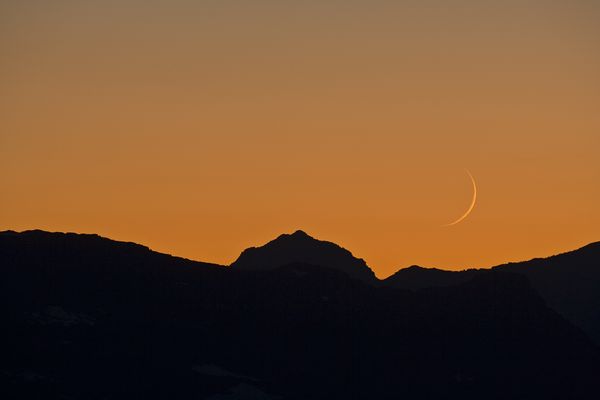
Because the moon's orbit is egg shaped, there are times in the roughly monthlong lunar cycle when the moon is at perigee - its closest distance to Earth - or at apogee, its farthest distance from Earth.
"A supermoon occurs when the moon is at perigee and it's in either a full or new phase," said Raminder Singh Samra, an astronomer at the H.R. MacMillan Space Centre in Vancouver, Canada.
In March sky-watchers were treated to a full moon at perigee, which made for the biggest full moon seen in 18 years.
(See "Supermoon Pictures: Best Shots of Biggest Full Moon.")
A new moon happens when the lunar orb positions itself between Earth and the sun, so that the side of the moon that faces Earth is unlighted.
"The upcoming moon on September 27, 2011, is set to be at perigee and at the new phase," Samra said, "so we won't be able to witness the event, as the moon and sun will be in the same region of the sky" and the lunar disk will be entirely dark.
Supermoon to Affect Earth's Tides?
Because the size of the moon's orbit also varies slightly, each perigee is not always the same distance from Earth.
When at perigee, the moon is about 18,640 miles (30,000 kilometers) closer to Earth than its average distance of roughly 240,000 miles (385,000 kilometers). When perigee occurs during a full moon, the lunar disk can appear about 14 percent bigger in the sky, Samra said.
Tuesday's dark supermoon will be just 222,175 miles (357,557 kilometers) away from Earth.
Some people have speculated that this lunar proximity can have unusual gravitational effects on Earth, triggering dramatic events such as earthquakes.
(Take a moon myths and mysteries quiz.)
But the truth is that there's only a very small correlation between full or new moons and seismic stresses, said Jim Todd, planetarium manager at the Oregon Museum of Science and Industry.
"Stronger tidal forces caused by the alignment of the sun and moon may put added stress on tectonic plates," Todd said.
"However, seismologists have found no evidence connecting lunar perigees to heightened seismic activity. Instead the Earth constantly stores up energy and releases it any time the built-up energy becomes too great."
Lunar close encounters are well known to cause slightly higher ocean tides, so any localized flooding during a supermoon would be most noticeable around beaches and other low-lying areas.
(Related: "Hurricane Irene 'Looking Bad' for U.S. - Moon May Make It Worse.")
But linking the supermoon to effects beyond that is far-fetched, the H.R. MacMillan Space Centre's Samra said.
"While the supermoon is thought to provoke various natural disasters on the Earth," he said, "such claims are exaggerations, as there is simply no scientific evidence for them."



Reader Comments
Earth Stores & Releases Energy-Release HOW?
Straws and Camels?
MR. SCIENCE SAYS: "Instead the Earth constantly stores up energy and releases it any time the built-up energy becomes too great."
Sounds like MAGIC!!!
Even if the universe was explained completely by Newtonian Physics, (there's more to it than that, of course), then that alone requires geological gravitational stresses on the earth by the moon and of course results in what HE calls "only a very small correlation between full or new moons and seismic stresses."
Has he ever heard about loading a camel with straw???
R.C.